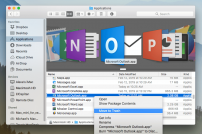

Give your rule a name – Out of Office seems appropriate. Under "Step 2: Setup rule Options" make sure the rule is turned on and click Finish and then OK twice to close out of the wizard. Note that the Rules Wizard will send your automated reply one time to each sender during a session - each time you open Outlook. The rule prevents sending repetitive replies to a single sender you receive multiple messages from. Remember that a new session will start if you close and restart the application.Īlso note that to send the automatic reply, Outlook must be running and configured to check for new messages periodically. Mac OS Monterey-Mojave Keyboard Shortcuts.

#CREATE RULES IN OUTLOOK 2016 FOR MAC MAC OS# Word and Excel (PC/Windows) 2021-2016 and 365Ĭreate a Mailbox Rule in Outlook: Overview.You can easily create a mailbox rule in Outlook. A mailbox rule in Outlook applies various actions to Outlook messages that match a specified set of criteria, and which are either sent or received from the mailbox. You can have multiple rules applied to a single mailbox. The rules are acted upon in sequence from top to bottom through the list of rules created for that mailbox. They can also be modified or deleted later, if they no longer apply. Outlook also allows you to turn them on and off without having to delete and recreate them. To create a mailbox rule in Outlook, first select the mailbox folder for which you want to create a rule. To then start the “Rules Wizard” to help you create the rule, click the “Rules” drop-down button in the “Move” button group on the “Home” tab of the Ribbon. Then select the “Manage Rules & Alerts…” command from the button’s drop-down menu to open the “Rules and Alerts” dialog box. Click the “E-mail Rules” tab in this dialog box, if needed, and then click the “New Rule…” button in the upper-left corner of the tab to launch the “Rules Wizard” dialog box. In the “Rules Wizard” dialog box that then opens, select a template from the list in the “Step 1: Select a template” section. The rule’s description then appears in the “Step 2: Edit the rule description” section at the bottom of the dialog box. For most of the rules, you must then click the hyperlinks that appear in this section. Doing this lets you “fill-in-the-blanks” in the rule template by entering additional information into the dialog boxes that open. The dialog boxes that appear vary, depending on the template selected. #CREATE RULES IN OUTLOOK 2016 FOR MAC MAC OS#.


 0 kommentar(er)
0 kommentar(er)
